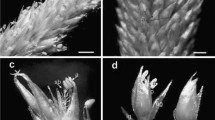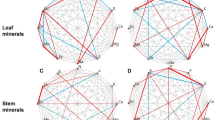Summary
The frequency at which sexual embryo sacs occur in some facultatively apomictic species is influenced by photoperiod. This research was conducted to study changes in the frequency of sexual embryo sacs (SES) in field-grown accessions of buffelgrass [Pennisetum ciliare (L.) Link] and to determine the influence of photoperiod on the expression of sexuality under controlled environmental conditions. In a 3-yr field study, mean frequency of SES collected from two facultative buffelgrass accessions (PI 409266 and 409277) ranged from 2.5 to 8.6 percent. Within each year, the greatest number of SES were observed during spring and summer, while a reduction in SES occurred during the late summer and early fall. Under controlled environmental conditions equal numbers of SES were observed from plants grown at 8, 12, and 16 h. For the two facultative accessions of buffelgrass examined in this study, it was concluded that no relationship existed between photoperiod and frequency of SES under either field or controlled environmental conditions.
Similar content being viewed by others
References
Bashaw E.C. & K.W. Hignight, 1990. Gene transfer in apomictic buffelgrass through fertilization of an unreduced egg. Crop Sci. 30: 571–575.
Bray R.A., 1978. Evidence for facultative apomixis in Cenchrus ciliaris. Euphytica 27: 801–804.
Burton, G.W. & I. Forbes Jr., 1960. The genetics and manipulation of obligate apomixis in common bahiagrass (Paspalum notatum Flugee) pp. 66–71. Proc. 8th Intl. Grassl. Congr.
de Wet J.M.J. & J.R. Harlan, 1970. Apomixis, polyploidy, and speciation in Dichanthium. Evolution 24: 270–277.
Evans L.T. & R.B. Knox, 1969. Environmental control of reproduction in Themeda australis. Aust. J. Bot. 17: 375–389.
Evers G.W., E.C. Holt & E.C. Bashaw, 1969. Seed production characteristics and photoperiod responses in buffelgrass, Cenchrus ciliaris L. Crop Sci. 9: 309–310.
Grazi F., M. Umaerus & E. Akenberg, 1961. Observations on the mode of reproduction and the embryology of Poa pratensis. Hereditas 47: 489–541.
Hanna W.W. & E.C. Bashaw, 1987. Apomixis: Its identification and use in plant breeding. Crop Sci. 27: 1136–1139.
Hanna W.W., J.B. Powell, C. Millot & G.W. Burton, 1973. Cytology of obligate sexual plants in Panicum maximum Jacq. and their use in controlled hybridization. Crop Sci. 13: 695–697.
Harlan J.R. & J.M.J.de Wet, 1963. Role of apomixis in the evolution of the Bothrichloa—Dichanthium complex. Crop Sci. 3: 314–316.
Hovin A.W., C.C. Berg, E.C. Bashaw, R.C. Buckner, D.R. Dewey, G.M. Dunn, C.S. Hoveland, C.M. Rincker & G.M. Wood, 1976. Effects of geographic origin and seed production environments on apomixis in Kentucky bluegrass. Crop Sci. 16: 635–638.
Knox R.B. & J. Heslop-Harrison, 1963. Experimental control of aposporous apomixis in a grass of the Andropogoneae. Botaniska Notiser 116: 127–141.
Knox R.B., 1967. Apomixis: seasonal and population differences in a grass. Science 157: 325–326.
Quarin C.L., 1986. Seasonal changes in the incidence of apomixis of diploid, triploid, and tetraploid plants of Paspalum cromyorrhizon. Euphytica 35: 515–522.
Savidan, Y.H., 1982. Genetics and utilization of apomixis for the improvement of guineagrass (Panicum maximum Jacq.) pp. 182–184. In: Proc. XIV Int. Grass Congr., Lexington, KY.
Sherwood R.T., B.A. Young & E.C. Bashaw, 1980. Facultative apomixis in buffelgrass. Crop Sci. 20: 375–379.
Taliaffero C.M. & E.C. Bashaw, 1966. Inheritance and control of obligate apomixis in breeding buffelgrass, Pennisetum ciliare. Crop Sci. 6: 473–476.
Tothill J.C. & R.B. Knox, 1968. Reproduction in Heteropogon contortus. I. Photoperiod effects on flowering and sex expression. Aust. J. Agric. Res. 19: 869–878.
Voigt P.W., 1971. Discovery of sexuality in Eragiostis curvula (Schrad.) Nees. Crop Sci. 11: 424–425.
Author information
Authors and Affiliations
Rights and permissions
About this article
Cite this article
Hussey, M.A., Bashaw, E.C., Hignight, K.W. et al. Influence of photoperiod on the frequency of sexual embryo saes in facultative apomictic buffelgrass. Euphytica 54, 141–145 (1991). https://doi.org/10.1007/BF00039600
Received:
Accepted:
Issue Date:
DOI: https://doi.org/10.1007/BF00039600




